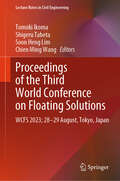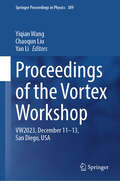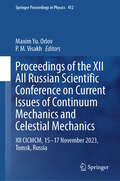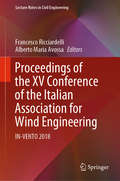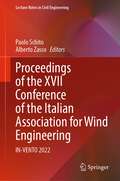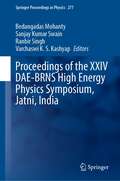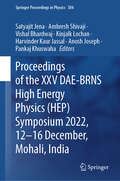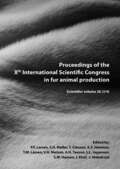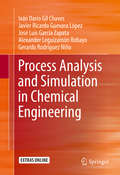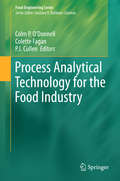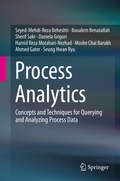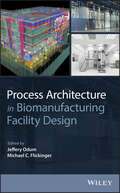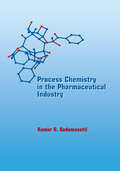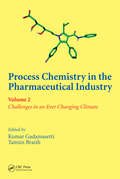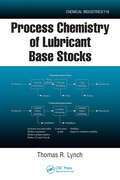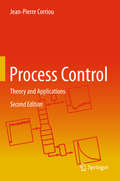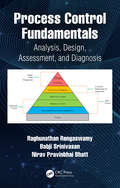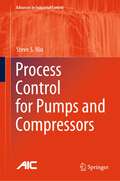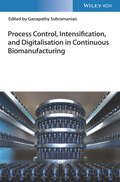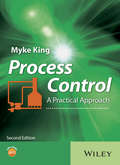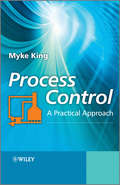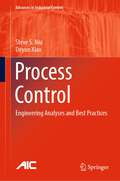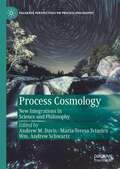- Table View
- List View
Proceedings of the Third World Conference on Floating Solutions: WCFS 2023; 28–29 August, Tokyo, Japan (Lecture Notes in Civil Engineering #465)
by Chien Ming Wang Soon Heng Lim Tomoki Ikoma Shigeru TabetaThis book includes peer-reviewed articles from the Third World Conference on Floating Solutions WCFS 2023 Japan with an aim to pioneer the SDGs and Next SDGs by making the most use of oceans and water. In recent years, the safety and security of people's lives around the world have been threatened by frequent floods and rising sea levels attributable to climate change. The COP 26 has set a common global goal of limiting the temperature rise to 1.5 degrees Celsius above pre-industrial levels. It is an urgent task to cope with climate change as well as to utilize decarbonized and renewable energy. The UN is promoting the SDGs which aim to achieve 17 Goals between 2015 and 2030. However, efforts to reach the Goals will not end in 2030 but will be an ongoing challenge for humanity beyond 2030. Here, we tentatively call the Goals to be achieved after the SDGs as "Next SDGs." Ocean and water have the potential to provide solutions to the disasters such as flooding and sea level rise due to climate change. In this context, WCFS 2023 presents ocean and water as the urban infrastructure and explores new technology and feasible solutions. In particular, it is necessary to consider urban planning, marine architecture, port planning connecting land and sea, disaster prevention, renewable energy, and food production on the sea and water. Further, it is indispensable that knowledge, experience, dream, and strong desire to realize these challenges are supported by a diversity of people.
Proceedings of the Vortex Workshop: VW2023, December 11-13, San Diego, USA (Springer Proceedings in Physics #254)
by Yan Li Chaoqun Liu Yiqian WangWritten by the leading experts in the field, this book results from Vortex Workshop 2023 which took place in San Diego, the USA, on December 11–13. Vortex is ubiquitous in the universe such as tornado, hurricane, airplane tip vortex, and even star vortex in Galaxy. Vortices are also building blocks, muscles, and sinews of turbulent flows. A vortex is intuitively recognized as a rotational/swirling motion of fluids but until recently had no rigidly mathematical definition. In 1858, Helmholtz first defined vortex as composed of so-called vortex filaments, which are infinitesimal vorticity tubes, which is called as the first generation of vortex definition and identification, or G1. Although G1 has been accepted by the fluid dynamics community and almost all textbooks for over a century, we can find many immediate counterexamples, for example, in the laminar boundary layer, where the vorticity (shear) is very large near the wall, but not rotation (no vortex) exists. To solve these contradictions, many vortex criteria methods have been developed during the past 4 decades. More popular methods are represented by the Q, ∆, criteria methods. These methods have achieved part of success in vortex identification, which are called the second generation of vortex identification or G2. However, G2 has several critical drawbacks. First, they are all scalars which have no rotation axis directions, but vortex is a vector. It is hard or impossible to use a scalar to represent a vector. Second, like vorticity, these criteria methods are all contaminated by shear in different degrees. Third, they are all very sensitive on threshold selections. The recently developed Liutex is called the third generation of vortex definition and identification, or G3, which is a uniquely defined vector.
Proceedings of the XII All Russian Scientific Conference on Current Issues of Continuum Mechanics and Celestial Mechanics: XII CICMCM, 15-17 November 2023, Tomsk, Russia (Springer Proceedings in Physics #1067)
by P. M. Visakh Maxim Yu. OrlovThis book presents peer reviewed articles from The XII All Russian Scientific Conference on Current issues of Continuum Mechanics and Celestial Mechanics (XII CICMCM), held on 15-17 November 2023, at Toms in, Russia. It summarizes the latest studies on shock and explosive loading of promising materials, including functionally graded materials, porous materials, multilayer ceramic structures, advanced materials and etc. It provides a platform for researchers (and professionals) to exchange ideas and present the latest findings in these important and growing areas of applied physics and engineering.
Proceedings of the XV Conference of the Italian Association for Wind Engineering: IN-VENTO 2018 (Lecture Notes in Civil Engineering #27)
by Francesco Ricciardelli Alberto Maria AvossaThis volume gathers the latest advances, innovations, and applications in the field of wind engineering, as presented by leading international researchers and engineers at the XV Conference of the Italian Association for Wind Engineering (IN-VENTO 2018), held in Naples, Italy on September 9-12, 2018. It covers highly diverse topics, including aeroelasticity, bluff-body aerodynamics, boundary layer wind tunnel testing, computational wind engineering, structural dynamics and reliability, wind-structure interaction, flow-induced vibrations, wind modeling and forecast, wind disaster mitigation, and wind climate assessment. The contributions, which were selected by means of a rigorous international peer-review process, highlight numerous exciting ideas that will spur novel research directions and foster multidisciplinary collaboration among different specialists.
Proceedings of the XVII Conference of the Italian Association for Wind Engineering: IN-VENTO 2022 (Lecture Notes in Civil Engineering #461)
by Paolo Schito Alberto ZassoThis volume gathers the latest advances, innovations, and applications in the field of wind engineering, as presented by leading international researchers and engineers at the XVII Conference of the Italian Association for Wind Engineering (IN-VENTO), held in Milan, Italy on September 4–7, 2022. It covers highly diverse topics, including aeroelasticity, bluff-body aerodynamics, boundary layer wind tunnel testing, computational wind engineering, structural dynamics and reliability, wind-structure interaction, flow-induced vibrations, wind modeling and forecast, wind disaster mitigation, and wind climate assessment. The contributions, which were selected by means of a rigorous international peer-review process, highlight numerous exciting ideas that will spur novel research directions and foster multidisciplinary collaboration among different specialists.
Proceedings of the XXIV DAE-BRNS High Energy Physics Symposium, Jatni, India (Springer Proceedings in Physics #277)
by Ranbir Singh Bedangadas Mohanty Sanjay Kumar Swain Varchaswi K. S. KashyapThis book presents proceedings from the XXIV DAE-BRNS High Energy Physics (HEP) Symposium 2020, held at the National Institute of Science Education and Research, Jatni, Odisha, India. The contributions cover a variety of topics in particle physics, astroparticle physics, cosmology and related areas from both experimental and theoretical perspectives, namely (1) Standard Model Physics, (2) Beyond Standard Model Physics, (3) Relativistic Heavy-Ion Physics & QCD, (4) Neutrino Physics, (5) Particle Astrophysics & Cosmology, (6) Detector Development Future Facilities and Experiments, (7) Formal Theory, (8) Societal Applications: Medical Physics, Imaging, etc.
Proceedings of the XXV DAE-BRNS High Energy Physics (Springer Proceedings in Physics #304)
by Anosh Joseph Satyajit Jena Ambresh Shivaji Vishal Bhardwaj Kinjalk Lochan Harvinder Kaur Jassal Pankaj KhuswahaThis book presents the proceedings of the XXV DAE-BRNS High Energy Physics (HEP) Symposium 2022, held at the Indian Institute of Science Education and Research Mohali, India. This proceeding marks the 25th edition. The latest results covering both the theoretical and the experimental aspects of the HEP research were presented under 10 broad topics ranging from Astroparticle and cosmology to Higgs and top quark physics, namely (1) article Astrophysics and Cosmology, (2) Beyond Standard Model Physics, (3) Formal Theory, (4) Detector Development Future Facilities and Experiments, (5) Relativistic Heavy-Ion Physics and QCD, (6) Higgs Physics, (7) Quark and Lepton Flavor Physics, (9) Societal Applications: Medical Physics, Imaging, and (10) Top Quark and EW Physics.
Proceedings of the Xth International Scientific Congress in Fur Animal Production
by A. H. Tauson P. F. Larsen S. H. Møller L. L. Jeppesen A. S. Hammer J. Elnif S. W. Hansen T. M. Lássen T. Clausen V. H. Nielsen J. MalmkvistThese proceedings present the latest achievements and developments within the scientific community of fur animal research organised by the International Fur Animal Scientific Association (IFASA). The book contains papers on the following topics: nutrition, feeding and management, health and disease, breeding, genetics and reproduction, behaviour and welfare and a theme on 'WelFur for mink and foxes'. The scientific results presented do not only come from traditional mink producing countries, but also from countries with more recent developments in fur animal production. The scientific community in the field of fur animal production is small, but the biologic diversity and thus the need for scientifically based knowledge in this area is similar to, or often exceeds, that of other farm animals. In this book, the most diverse and recent advancements in fur animal production were brought together in order to provide a clear overview for all those involved in the fur animal industry.
Process Analysis and Simulation in Chemical Engineering
by Iván Darío Gil Chaves Javier Ricardo Guevara López José Luis García Zapata Alexander Leguizamón Robayo Gerardo Rodríguez NiñoThis book offers a comprehensive coverage of process simulation and flowsheeting, useful for undergraduate students of Chemical Engineering and Process Engineering as theoretical and practical support in Process Design, Process Simulation, Process Engineering, Plant Design, and Process Control courses. The main concepts related to process simulation and application tools are presented and discussed in the framework of typical problems found in engineering design. The topics presented in the chapters are organized in an inductive way, starting from the more simplistic simulations up to some complex problems.
Process Analytical Technology for the Food Industry
by P. J. Cullen Colm P. O'Donnell Colette FaganThe Process Analytical Technology (PAT) initiative aims to move from a paradigm of 'testing quality in' to 'building quality in by design'. It can be defined as the optimal application of process analytical technologies, feedback process control strategies, information management tools, and/or product-process optimization strategies. Recently, there have been significant advances in process sensors and in model-based monitoring and control methodologies, leading to enormous opportunities for improved performance of food manufacturing processes and for the quality of food products with the adoption of PAT. Improvements in process efficiency, reduced product variability, enhanced traceability, process understanding, and decreased risk of contamination are some of the benefits arising from the introduction of a PAT strategy in the food industry. Process Analytical Technology for the Food Industry reviews established and emerging PAT tools with potential application within the food processing industry. The book will also serve as a reference for industry, researchers, educators, and students by providing a comprehensive insight into the objectives, challenges, and benefits of adopting a Process Analytical Technology strategy in the food industry.
Process Analytics
by Seyed-Mehdi-Reza Beheshti Boualem Benatallah Sherif Sakr Daniela Grigori Hamid Reza Motahari-Nezhad Moshe Chai Barukh Ahmed Gater Seung Hwan RyuThis book starts with an introduction to process modeling and process paradigms, then explains how to query and analyze process models, and how to analyze the process execution data. In this way, readers receive a comprehensive overview of what is needed to identify, understand and improve business processes. The book chiefly focuses on concepts, techniques and methods. It covers a large body of knowledge on process analytics - including process data querying, analysis, matching and correlating process data and models - to help practitioners and researchers understand the underlying concepts, problems, methods, tools and techniques involved in modern process analytics. Following an introduction to basic business process and process analytics concepts, it describes the state of the art in this area before examining different analytics techniques in detail. In this regard, the book covers analytics over different levels of process abstractions, from process execution data and methods for linking and correlating process execution data, to inferring process models, querying process execution data and process models, and scalable process data analytics methods. In addition, it provides a review of commercial process analytics tools and their practical applications. The book is intended for a broad readership interested in business process management and process analytics. It provides researchers with an introduction to these fields by comprehensively classifying the current state of research, by describing in-depth techniques and methods, and by highlighting future research directions. Lecturers will find a wealth of material to choose from for a variety of courses, ranging from undergraduate courses in business process management to graduate courses in business process analytics. Lastly, it offers professionals a reference guide to the state of the art in commercial tools and techniques, complemented by many real-world use case scenarios.
Process Architecture in Biomanufacturing Facility Design
by Michael C. Flickinger Jeffery OdumEssential information for architects, designers, engineers, equipment suppliers, and other professionals who are working in or entering the biopharmaceutical manufacturing field Biomanufacturing facilities that are designed and built today are radically different than in the past. The vital information and knowledge needed to design and construct these increasingly sophisticated biopharmaceutical manufacturing facilities is difficult to find in published literature—and it’s rarely taught in architecture or design schools. This is the first book for architects and designers that fills this void. Process Architecture in Biomanufacturing Facility Design provides information on design principles of biopharmaceutical manufacturing facilities that support emerging innovative processes and technologies, use state-of-the-art equipment, are energy efficient and sustainable, and meet regulatory requirements. Relying on their many years of hands-on design and operations experience, the authors emphasize concepts and practical approaches toward design, construction, and operation of biomanufacturing facilities, including product-process-facility relationships, closed systems and single use equipment, aseptic manufacturing considerations, design of biocontainment facility and process based laboratory, and sustainability considerations, as well as an outlook on the facility of the future. Provides guidelines for meeting licensing and regulatory requirements for biomanufacturing facilities in the U.S.A and WHO—especially in emerging global markets in India, China, Latin America, and the Asia/Pacific regions Focuses on innovative design and equipment, to speed construction and time to market, increase energy efficiency, and reduce footprint, construction and operational costs, as well as the financial risks associated with construction of a new facility prior to the approval of the manufactured products by regulatory agencies Includes many diagrams that clarify the design approach Process Architecture in Biomanufacturing Facility Design is an ideal text for professionals involved in the design of facilities for manufacturing of biopharmaceuticals and vaccines, biotechnology, and life-science industry, including architects and designers of industrial facilities, construction, equipment vendors, and mechanical engineers. It is also recommended for university instructors, advanced undergraduates, and graduate students in architecture, industrial engineering, mechanical engineering, industrial design, and industrial interior design.
Process Chemistry in the Pharmaceutical Industry
by Kumar G. GadamasettiProviding guidance for chemists and other scientists entering pharmaceutical discovery and development, this up-to-the-minute reference presents contributions from an international group of nearly 50 renowned researchers-offering a solid grounding in synthetic and physical organic chemistry, and clarifying the roles of various special
Process Chemistry in the Pharmaceutical Industry, Volume 2: Challenges in an Ever Changing Climate
by Kumar Gadamasetti Tamim BraishAs pharmaceutical companies strive to develop safer medicines at a lower cost, they must keep pace with the rapid growth of technology and research methodologies. Defying the misconception of process chemistry as mere scale-up work, Process Chemistry in the Pharmaceutical Industry, Vol. 2: Challenges in an Ever Changing Climate explor
Process Chemistry of Lubricant Base Stocks (Chemical Industries)
by Thomas R. LynchAdvances in processing methods are not only improving the quality and yield of lubricant base stocks, they are also reducing the dependence on more expensive crude oil starting materials. Process Chemistry of Lubricant Base Stocks provides a comprehensive understanding of the chemistry behind the processes involved in petroleum base stock p
Process Control
by Jean-Pierre CorriouThis reference book can be read at different levels, making it a powerful source of information. It presents most of the aspects of control that can help anyone to have a synthetic view of control theory and possible applications, especially concerning process engineering.
Process Control Engineering
by A.Ramachandro. RaoProcess Control Engineering is a textbook for chemical, mechanical and electrical engineering students, providing the theoretic fundamentals of control systems, and highlighting modern control theory and practical aspects of industrial processes. The introductory nature of the text should appeal to undergraduate students, while later chapters on linear systems, optimal control, adaptive control and intelligent control are directed toward advanced students and practising engineers. The textbook has been extensively tested in both undergraduate and graduate courses at the University of Alberta.
Process Control Fundamentals: Analysis, Design, Assessment, and Diagnosis
by Raghunathan Rengaswamy Babji Srinivasan Nirav Pravinbhai BhattThe field of process control has evolved gradually over the years, with emphasis on key aspects including designing and tuning of controllers. This textbook covers fundamental concepts of basic and multivariable process control, and important monitoring and diagnosis techniques. It discusses topics including state-space models, Laplace transform to convert state-space models to transfer function models, linearity and linearization, inversion formulae, conversion of output to time domain, stability analysis through partial fraction expansion, and stability analysis using Routh table and Nyquits plots. The text also covers basics of relative gain array, multivariable controller design and model predictive control. The text comprehensively covers minimum variable controller (MVC) and minimum variance benchmark with the help of solved examples for better understanding. Fundamentals of diagnosis of control loop problems are also explained and explanations are bolstered through solved examples. Pedagogical features including solved problems and unsolved exercises are interspersed throughout the text for better understanding. The textbook is primarily written for senior undergraduate and graduate students in the field of chemical engineering and biochemical engineering for a course on process control. The textbook will be accompanied by teaching resource such a collection of slides for the course material and a includsolution manual for the instructors.
Process Control for Pumps and Compressors (Advances in Industrial Control)
by Steve S. NiuThis book provides a summary of the essential knowledge and working processes involved with control of rotating equipment including:machine characteristics;overall control strategies;detailed design; andbest practices.Emphasis is placed on the role of pumps and compressors as part of the overall process flow rather than treating them in isolation as this tends to optimize energy efficiency.Readers are made aware of the critical roles of rotating equipment and are given a good understanding of their dynamic behaviors, including surge/choke. The author imparts the practical know-how and skills involved in the design and implementation of capacity and anti-surge control and safe-guarding logic. Furthermore, the book discusses real-time monitoring of solutions based on operational requirements, dynamic models for control of supply and demand, cause-and-effect relationships, the use of online and offline data, and collaboration with other engineering disciplines. The text facilitates support for the day-to-day operation of in-house open-platform compressor control applications, encouraging the growth of analytic skills in troubleshooting and fixing common problems; it also inculcates a basic understanding of the principles of third-party proprietary technologies and supports decision-making between in-house and third-party solutions.Process engineers working in the oil-and-gas, refining, petrochemical, and chemical industries who bear responsibility for designing control solutions involving pumps and compressors will find this book an invaluable source of practical advice. This book also helps engineers working on design and maintenance of rotating equipment to understand the perspectives and requirements of process control.
Process Control, Intensification, and Digitalisation in Continuous Biomanufacturing
by Ganapathy SubramanianProcess Control, Intensification, and Digitalisation in Continuous Biomanufacturing Explore new trends in continuous biomanufacturing with contributions from leading practitioners in the field With the increasingly widespread acceptance and investment in the ??technology, the last decade has demonstrated the utility of continuous ??processing in the pharmaceutical industry. In Process Control, Intensification, and Digitalisation in Continuous Biomanufacturing, distinguished biotechnologist Dr. Ganapathy Subramanian delivers a comprehensive exploration of the potential of the continuous processing of biological products and discussions of future directions in advancing continuous processing to meet new challenges and demands in the manufacture of therapeutic products. A stand-alone follow-up to the editor’s Continuous Biomanufacturing: Innovative Technologies and Methods published in 2017, this new edited volume focuses on critical aspects of process intensification, process control, and the digital transformation of biopharmaceutical processes. In addition to topics like the use of multivariant data analysis, regulatory concerns, and automation processes, the book also includes: Thorough introductions to capacitance sensors to control feeding strategies and the continuous production of viral vaccines Comprehensive explorations of strategies for the continuous upstream processing of induced microbial systems Practical discussions of preparative hydrophobic interaction chromatography and the design of modern protein-A-resins for continuous biomanufacturing In-depth examinations of bioprocess intensification approaches and the benefits of single use for process intensification Perfect for biotechnologists, bioengineers, pharmaceutical engineers, and process engineers, Process Control, Intensification, and Digitalisation in Continuous Biomanufacturing is also an indispensable resource for chemical engineers seeking a one-stop reference on continuous biomanufacturing.
Process Control: A Practical Approach
by Myke KingSo why another book on process control? Process Control: A Practical Approach is a ground-breaking guide that provides everything needed to design and maintain process control applications. <P><P>The book follows the hierarchy from basic control, through advanced regulatory control, up to and including multivariable control. It addresses many process-specific applications including those on fired heaters, compressors and distillation columns. <P><P>Written with the practicing control engineer in mind, the book: Brings together proven design methods, many of which have never been published before Focuses on techniques that have an immediate practical application Minimizes the use of daunting mathematics - but for the more demanding reader, complex mathematical derivations are included at the end of each chapter Covers the use of all the algorithms, common to most distributed control systems This book raises the standard of what might be expected of even basic controls. In addition to the design methods it describes any shortcuts that can be taken and how to avoid common pitfalls. Proper application will result in significant improvements to process performance. Myke King's practical approach addresses the needs of the process industry, and will improve the working practices of many control engineers. "This book would be of value to process control engineers in any country." - Mr Andrew Ogden-Swift, Chairmain, Process Management and Control Subject Group, Institution of Chemical Engineers, UK "This book should take the process-control world by storm." - Edward Dilley, Lecturer in Process Control, ESD Simulation Training
Process Control: A Practical Approach
by Myke KingThis expanded new edition is specifically designed to meet the needs of the process industry, and closes the gap between theory and practice. Back-to-basics approach, with a focus on techniques that have an immediate practical application, and heavy maths relegated to the end of the book Written by an experienced practitioner, highly regarded by major corporations, with 25 years of teaching industry courses Supports the increasing expectations for Universities to teach more practical process control (supported by IChemE)
Process Control: A Practical Approach
by Myke KingSo why another book on process control? Process Control: A Practical Approach is a ground-breaking guide that provides everything needed to design and maintain process control applications. The book follows the hierarchy from basic control, through advanced regulatory control, up to and including multivariable control. It addresses many process-specific applications including those on fired heaters, compressors and distillation columns. Written with the practicing control engineer in mind, the book: Brings together proven design methods, many of which have never been published before Focuses on techniques that have an immediate practical application Minimizes the use of daunting mathematics – but for the more demanding reader, complex mathematical derivations are included at the end of each chapter Covers the use of all the algorithms, common to most distributed control systems This book raises the standard of what might be expected of even basic controls. In addition to the design methods it describes any shortcuts that can be taken and how to avoid common pitfalls. Proper application will result in significant improvements to process performance. Myke King’s practical approach addresses the needs of the process industry, and will improve the working practices of many control engineers. “This book would be of value to process control engineers in any country.” – Mr Andrew Ogden-Swift, Chairmain, Process Management and Control Subject Group, Institution of Chemical Engineers, UK “This book should take the process-control world by storm.” – Edward Dilley, Lecturer in Process Control, ESD Simulation Training
Process Control: Engineering Analyses and Best Practices (Advances in Industrial Control)
by Steve S. Niu Deyun XiaoProcess Control details the core knowledge and practical skills that a successful process control practitioner needs. It explains the essential technologies that are in use in current industrial practice or which may be wanting for the future. The book focuses on practical considerations, not only on those that make a control solution work, but also on those that prevent it from failing, especially for complex control loops and plant-wide control solutions.After discussing the indispensable role of control in modern process industries, the authors concentrate on the skills required for process analysis, control design, and troubleshooting. One of the first books to provide a systematic approach and structured methodology for process analysis and control design, Process Control illustrates that methodology with many practical examples that cover process control, equipment control, and control calculations derived from real projects and applications. The book uses 229 drawings and 83 tables to make the concepts it presents more intuitive and its methodology easy to follow.Process Control will help the practising control engineer to benefit from a wealth of practical experience and good ideas on how to make control work in the real world and students training to take up roles in process control are shown the applied relevance of control theory in the efficient functioning of industrial plant and the considerations needed to make it work.Advances in Industrial Control reports and encourages the transfer of technology in control engineering. The rapid development of control technology has an impact on all areas of the control discipline. The series offers an opportunity for researchers to present an extended exposition of new work in all aspects of industrial control.
Process Cosmology: New Integrations in Science and Philosophy (Palgrave Perspectives on Process Philosophy)
by Andrew M. Davis Maria-Teresa Teixeira Wm. Andrew SchwartzThis book newly articulates the international and interdisciplinary reach of Whitehead’s organic process cosmology for a variety of topics across science and philosophy, and in dialogue with a variety historical and contemporary voices. Integrating Whitehead’s thought with the insights of Bergson, James, Pierce, Merleau-Ponty, Descola, Fuchs, Hofmann, Grof and many others, contributors from around the world reveal the relevance of process philosophy to physics, cosmology, astrobiology, ecology, metaphysics, aesthetics, psychedelics, and religion. A global collection, this book expresses multivocal possibilities for the development of process cosmology after Whitehead.
